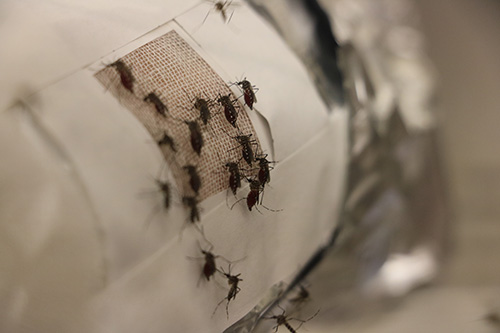
PROVIDENCE – Brown University researchers have found a new use for the nanomaterial graphene: preventing mosquito bites.
In a paper published recently in the Proceedings of the National Academy of Sciences, researchers showed that clothing with multilayers of graphene could provide a two-fold defense against mosquito bites.
Researchers found the strong but ultra-thin material acts as a barrier that mosquitoes can’t bite through. Also, experiments showed that graphene blocks chemical signals mosquitoes use to sense that a blood meal is near.
The study findings come as concern about mosquito-borne Eastern equine encephalitis grows in southeastern New England. A Fairhaven woman died in August after contracting EEE. Several other Massachusetts residents tested positive for EEE in August.
“Mosquitoes are important vectors for disease all over the world, and there’s a lot of interest in nonchemical mosquito-bite protection,” Robert Hurt, a professor in Brown’s School of Engineering, leader of Brown’s Superfund Research Program and senior author of the paper, said in a Brown news release. “We had been working on fabrics that incorporate graphene as a barrier against toxic chemicals, and we started thinking about what else the approach might be good for. We thought maybe graphene could provide mosquito-bite protection as well.”
To find out if it would work, participants in the study placed their arms in an enclosure filled with disease-free mosquitoes so that only a small patch of their skin was available to the mosquitoes for biting.
The researchers compared the number of bites participants received on their bare skin, on skin covered in cheesecloth and on skin covered by graphene oxide films sheathed in cheesecloth. Graphene oxide is a graphene derivative that can be made into films large enough for macro-scale applications.
When skin was covered by dry graphene oxide films, participants didn’t get a single bite, while bare and cheesecloth-covered skin received many bites. Researchers said the mosquitoes completely changed their behavior in the presence of the graphene-covered arm.
“With the graphene, the mosquitoes weren’t even landing on the skin patch – they just didn’t seem to care,” said Cintia Castillho, a Ph.D. student at Brown and the study’s lead author. “We had assumed that graphene would be a physical barrier to biting, through puncture resistance, but when we saw these experiments, we started to think that it was also a chemical barrier that prevents mosquitoes from sensing that someone is there.”
The researchers then dabbed some human sweat onto the outside of a graphene barrier. With the chemical cues on the other side of the graphene, the mosquitoes were drawn to the patch.
Other experiments showed that graphene oxide can also provide puncture resistance when dry but was vulnerable when wet. However, another form of graphene oxide with reduced oxygen content was shown to provide a bite barrier when both wet and dry.
A next step for the research would be to find a way to strengthen the graphene oxide when it’s wet, Hurt said. That’s because the material has a distinct advantage over the reduced oxygen version because it’s breathable, meaning sweat can move through when worn as clothing.
Other co-authors on the study were Dong Li, Muchun Liu, Yue Liu and Huajian Gao. The study was funded by the National Institute of Environmental Health Sciences, Superfund Research Program and the National Science Foundation.












